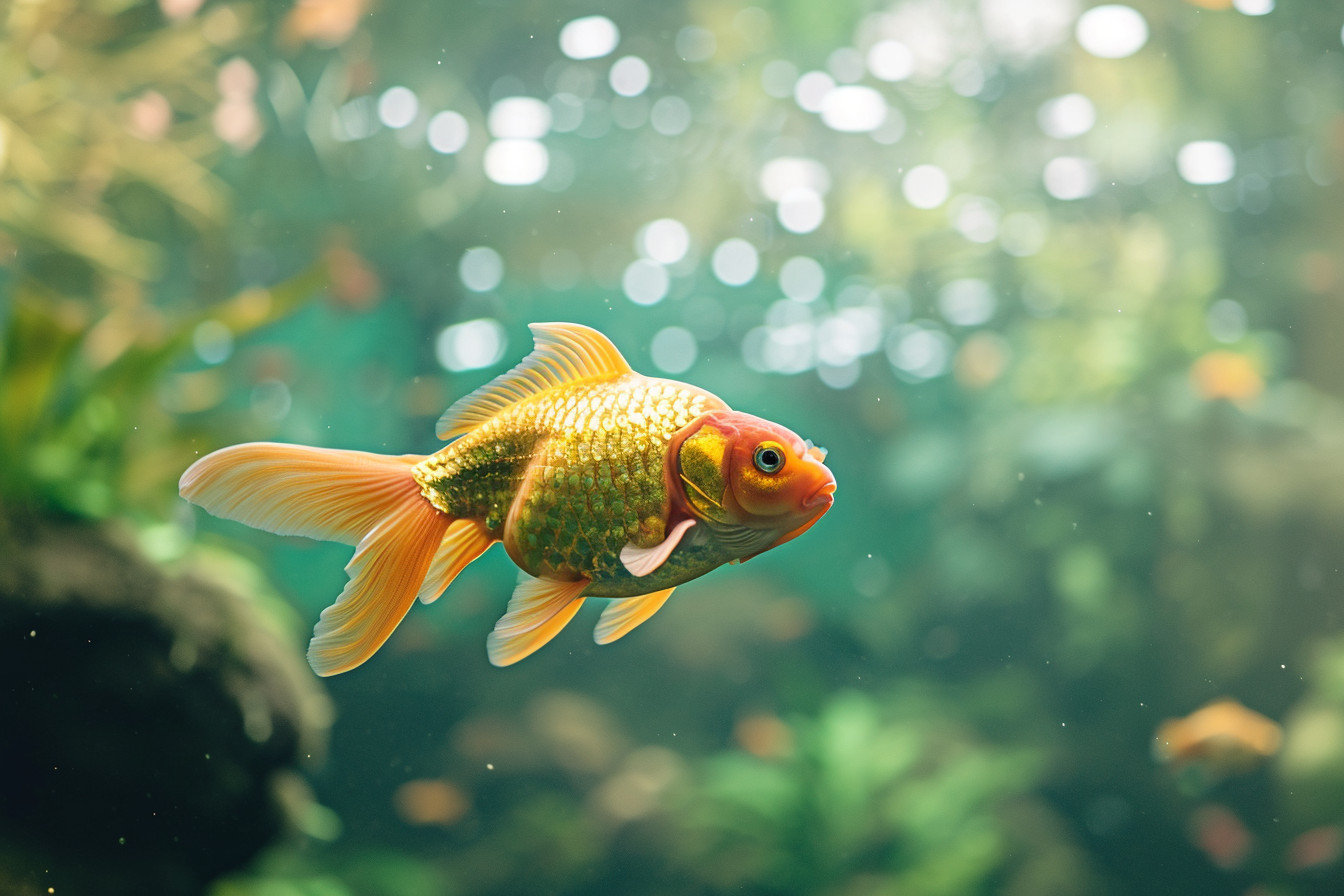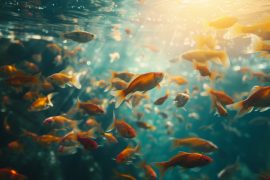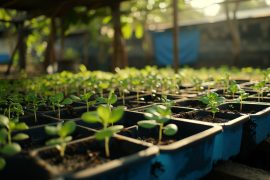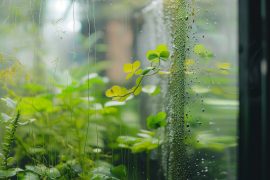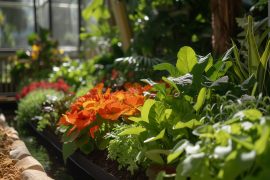Ever find yourself marveling at the idea of growing veggies and raising fish together? That’s the magic of aquaponics, a system I’ve fallen in love with. It’s like having your cake and eating it too—combining fish farming with hydroponics to create a self-sustaining ecosystem.
In the heart of this setup, you’ve got the fish—more than just underwater pets, they’re the powerhouse behind the nutrients your plants crave. As a beginner, you’ll be amazed at how these finned friends can turn your gardening game around.
What is Aquaponics?
Ever wandered into a garden and felt that undeniable sense of peace? There’s something magical about tending to plants and being part of a space that’s so tranquil and full of life. Now, imagine adding the gentle murmur of water and the soft movement of fish to the mix. That’s aquaponics for you—a serene symphony of gardening and aquaculture.
As someone who fell in love with plants and fish alike, I’ve always been enthralled by the idea of combining the two. It’s like having the best of both worlds! Aquaponics is this incredibly smart way of making your gardening space not just a visual treat but a self-sustaining ecosystem as well.
In its essence, aquaponics is about growing plants and fish together in one integrated system. The fish waste provides an organic nutrient source for the plants, and the plants help to filter and purify the water, which then recirculates back to the fish tanks. This closed-loop system mimics nature’s way of creating a harmonious environment for both plants and aquatic animals.
Think of it as a partnership—fish and plants striking a deal to support each other. I’ve seen firsthand how tilapia, for instance, thrive in this setup. They’re like the hard-working farmers of the underwater world, and in return, they get a clean house thanks to the plants.
But what’s really amazing is how accessible this system is. I remember being a bit intimidated by all the technical jargon at first. Terms like ‘nitrogen cycle’ and ‘biofilter’ had me a bit puzzled. But as I delved deeper, I realized it’s not as complex as it sounds. It’s all about breaking down the fish waste into usable nutrients for the plants. And you don’t need to be a botanist or a marine biologist to get it right.
Here are a few key points that helped me grasp the basics:
- The nitrogen cycle is pivotal in aquaponics. It’s like the cycle of life, but for your garden and fish.
- Fish produce ammonia as waste, and though it’s toxic to them, it’s gold for plants.
- Beneficial bacteria convert this ammonia into nitrates, which are fabulous for plant growth.
- The plants take up these nitrates, cleaning the water in the process.
The Basics of Fish Farming
As I delve into the serene world of aquaponics, a key component I’ve grown to appreciate is fish farming. It’s not just about raising fish but also about fostering an environment where both fish and plants thrive in symbiosis. It might sound technical, but trust me, it’s more harmonious than you’d think, and quite accessible once you get the hang of it.
Fish farming in aquaponics, known as aquaculture, is about creating a balanced aquatic environment where fish are more than just livestock—they’re a critical piece of a living system. Imagine a tranquil pond, a place where fish swim lazily, and you’re somewhat there. They play a pivotal role by providing the necessary nutrients for the plants above through their waste.
You don’t need a massive space to start. I’ve seen people set up small tanks in their backyards, even indoors. And the choice of fish? It’s quite expansive. Tilapia and goldfish are popular for beginners due to their hardiness and adaptability. But there’s more to consider than just the fish species when setting up your aquaculture system:
- Water Quality: This is your fish’s environment, so keeping it clean and at the right pH levels is vital.
- Temperature: Different fish require different temperatures. Research is key!
- Oxygen Levels: Fish need oxygen, so an aeration system is a must.
- Feeding: Overfeeding can pollute the water, while underfeeding affects the fish growth and health.
Through my own trial and error, I’ve learned that getting these variables right is crucial not just for the fish but also for the entire aquaponic system’s efficiency.
I can’t talk about fish without touching on the nitrogen cycle. As it turns out, fish waste isn’t immediately ready to be used by plants—it first needs to be broken down. That’s where beneficial bacteria come in, converting ammonia from the waste into nitrates that plants can absorb. This cycle is a fascinating biological process that’s both technical and yet beautifully simple.
The Role of Fish in Aquaponic Systems
When I first heard about aquaponics, I was struck by the beautiful symbiosis between plants and fish. It’s not just about growing veggies or rearing fish—it’s about cultivating life in harmony. Underneath the peaceful dance of fish in water lies an essential dynamic that fuels the entire aquaponic garden. Fish, my friends, are the powerhouse of this system.
Fish waste provides the nutrients plants need to grow. I like to think of fish as diligent workers, tirelessly contributing to the ecosystem in their own aquatic manner. Every day, as they swim and eat, they’re prepping a feast for the plants above. It’s their waste that kicks off a complex process called the nitrogen cycle, where beneficial bacteria convert ammonia from fish waste into nitrates, which plants can then absorb.
In aquaponic systems, you don’t just toss any fish in the water and hope for the best. No, there’s an art to selecting the right species. For beginners, I’ve found species like tilapia and goldfish to be forgiving and hardy—they’re like the first pets you’d love to have; they don’t fuss, and they thrive with minimal drama. On top of that, these fish are pretty adaptable to varying water conditions, which is excellent for newcomers getting a feel for the delicate balance of aquaponic gardening.
To make the most of these finned friends, it’s critical to keep their environment stable. I monitor the water quality, temperature, and oxygen levels with a careful eye. It’s almost like reading the mood of the room—if something’s off, the fish let you know, and it’s up to you to fix it before your plants catch wind of the trouble.
| Aspect | Ideal Range |
|---|---|
| Water Quality | Clear, uncontaminated, proper pH and low levels of ammonia and nitrites |
| Temperature | Species-specific but generally between 70-85°F (21-29°C) |
| Oxygen Levels | Sufficient for fish to thrive and support bacteria |
Choosing the Right Fish for Your System
When I started my journey into aquaponics, understanding the role of fish was like opening a door to a whole new garden. It was invigorating, like feeling the morning dew while checking on my leafy companions. But before getting lost in the tranquil world of floating rafts and babbling water, there’s a crucial step I learned to focus on: picking the right fish.
Ever watched a school of fish swim in perfect harmony? It’s like they’re choreographed by nature itself. That’s the kind of balance you want in your aquaponic system – fish that are naturally suited to the conditions you can provide. My choice had to consider factors like growth rate, temperature preferences, and their overall hardiness.
Here’s a basic guide that I followed when choosing the right fish for my system:
- Climate Compatibility: Your local climate plays a big part in this choice. If you live in a warmer area, you might consider fish like tilapia, which are accustomed to those temps. Cooler climates might mean looking at trout or perch.
- Space Requirements: Some fish need more room to swim and thrive. I ensured that my tank size matched the needs of the fish I wanted.
- Dietary Needs: Different fish require different diets. I wasn’t about to have the fish in my peaceful oasis stressing out over food.
- Local Regulations: Can’t forget about this one! Some species are restricted or have specific requirements based on where you live, so I made sure to check with local regulations before stocking my tank.
One thing I’ve seen consistently is that growers tend to favor Tilapia due to their tolerance to various water conditions and their rapid growth rate. And if you’re observing from a meditative mindset, their serene gliding is a sight for sore eyes.
Goldfish are another popular choice, especially for beginners, because they’re just so much simpler to care for. And let’s not forget the Koi. They are like the Zen masters of fish, bringing a touch of calm elegance to any system but do require a bit more space and attention.
| Fish Type | Temperature Range | Growth Rate | Space Required |
|---|---|---|---|
| Tilapia | 75-85°F (24-29°C) | Fast | Moderate |
| Gold |
Fish Care and Maintenance
Caring for fish in an aquaponic system isn’t just a chore; it’s a way to find serenity. There’s something truly peaceful about watching them swim in their watery home, a rhythm that’s soothing to the soul. They’re not only crucial for the plants’ growth but also bring balance and a touch of natural beauty to my garden space.
Feeding the Fish is an essential aspect of their care. It’s quite educational to learn what each species prefers. For instance, my tilapia thrive on a high-protein diet, something akin to what they’d find in their natural habitat. Every day, I take time to feed them, measuring their food carefully—too much and I could upset the delicate balance of the system; too little and the fish won’t provide enough nutrients for the plants.
I’ve found that observing their behaviors during feeding times can reveal a lot about their health and happiness. If they’re darting to the surface eagerly, it’s a good sign. Uneaten food, on the other hand, can lead to water quality issues, so I’m always careful to adjust portions based on their activity levels.
Monitoring Water Quality is another critical part of fish care. I make a habit of checking water pH, ammonia, nitrites, and nitrates regularly. These terms can sound technical, but really, they’re just indicators of whether the fish are living in a healthy environment. A sudden spike in ammonia or a shift in pH can be stressful for the fish, which can lead to bigger issues within the system.
Here’s a simple breakdown of the ideal ranges for an aquaponic system:
| Water Quality Parameter | Ideal Range |
|---|---|
| pH | 6.8 to 7.2 |
| Ammonia | Less than 0.5 ppm |
| Nitrite | Less than 1 ppm |
| Nitrate | 5 to 150 ppm |
Health Checks and Tank Cleaning are, admittedly, less meditative but equally essential. I examine the fish regularly for any signs of stress or disease—patches, spots, or erratic swimming can all be warning signs. Tank cleaning should be handled with care to not disrupt the fish too much. I use natural methods to control algae and make sure the sides of the tank are clean and clear.
Final Thought
So there you have it—my deep dive into the world of aquaponics and the crucial role fish play in these systems. Remember, the key is to choose the right fish for your setup and to keep a close eye on their health and environment. Stick to these guidelines and you’ll be on your way to creating a thriving aquaponic ecosystem. Happy fish keeping and farming!
